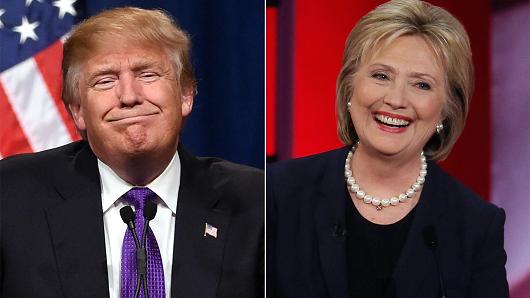
Poll: Clinton loses lead over Trump in Florida; too close in Ohio and Pennsylvania
With a drop in grades on honesty and moral standards, Democrat Hillary Clinton loses an 8-point lead over Republican Donald Trump in Florida, and finds herself in too-close-to-call races in the three critical swing states of Florida, Ohio and Pennsylvania, according to a Quinnipiac University Swing State Poll released today (Wednesday July 13).
Clinton loses ground on almost every measure from a June 21 survey by the independent Quinnipiac University. The Swing State Poll focuses on Florida, Ohio and Pennsylvania because since 1960 no candidate has won the presidential race without taking at least two of these three states.
The presidential matchups show:
- Florida – Trump at 42 percent to Clinton’s 39, compared to a 47 – 39 percent Clinton lead June 21;
- Ohio – Clinton and Trump tied 41 – 41 percent, compared to a 40 – 40 percent tie June 21;
- Pennsylvania – Trump at 43 percent to Clinton’s 41 percent, compared to June 21, when Clinton had 42 percent to Trump’s 41 percent.
With third party candidates in the race, results are:

- Florida – Trump leads Clinton 41 – 36 percent, with 7 percent for Libertarian Gary Johnson and 4 percent for Green Party candidate Jill Stein;
- Ohio – Trump at 37 percent to Clinton’s 36 percent, with Johnson at 7 percent and Stein at 6 percent;
- Pennsylvania – Trump over Clinton 40 – 34 percent with 9 percent for Johnson and 3 percent for Stein.
“Donald Trump enters the Republican Convention on a small roll in the three most important swing states in the country. He has wiped out Hillary Clinton’s lead in Florida; is on the upside of too-close to call races in Florida and Pennsylvania and is locked in a dead heat in Ohio,” said Peter A. Brown, assistant director of the Quinnipiac University Poll.
“While there is no definite link between Clinton’s drop in Florida and the U.S. Justice Department decision not to prosecute her for her handling of e-mails, she has lost ground to Trump on questions which measure moral standards and honesty.”
By wide margins, voters in each state agree with the statement, “The old way of doing things no longer works and we need radical change.” Voters also agree by wide margins that trade agreements with other countries have hurt them and their families’ financial situation.
Voters still say Clinton is more intelligent than Trump and that she is better prepared to be president. But Clinton has lost her wide lead over Trump for having “higher moral standards.” And Trump widens his lead over Clinton for being more honest and trustworthy.

FLORIDA
While the gender gap remains wide, Trump gains support among men, who back him 50 – 29 percent, and women, who back Clinton 48 – 36 percent, compared to 52 – 34 percent in June. Independent voters shift from 44 – 35 percent for Clinton last month to 43 – 30 percent for Trump today. Republicans back Trump 82 – 6 percent, while Clinton leads 87 – 4 among Democrats. White voters back Trump 54 – 30 percent, as non-white voters go to Clinton 56 – 21 percent.
Florida voters give Clinton and Trump negative favorability ratings, 35 – 59 percent for her and 38 – 54 percent for him.
Comparing the candidates’ character traits, voters say:
- 53 – 37 percent that Clinton is better prepared to be president;
- 42 – 42 percent tie on who has higher moral standards, wiping out a 47 – 36 percent Clinton lead on this measure June 21;
- 52 – 35 percent that Clinton is more intelligent;
- 50 – 37 percent that Trump is more honest and trustworthy, up from 43 – 40 percent.
Florida voters say 54 – 39 percent that Trump would be better creating jobs; 49 – 45 percent that he would do better on immigration and 57 – 35 percent that Trump would be more effective against ISIS.
Voters agree:
- 71 – 25 percent that the old ways don’t work and it’s time for radical change;
- 55 – 39 percent that foreign trade agreements have hurt them personally;
- 80 – 19 that public officials “don’t care much what people like me think.”
“In Florida, Donald Trump is getting only 21 percent of the non-white vote. Although he is winning among white voters, who are mainly Republican, victory in Florida will be a very difficult lift for him if he can’t do better among non-white voters,” Brown said.
OHIO
Disenchantment runs strong in the Rust Belt state of Ohio, where voters agree:
- 59 – 39 percent that they are falling further and further behind economically;
- 73 – 24 percent that the old ways don’t work and it’s time for radical change;
- 59 – 37 percent that foreign trade agreements have hurt them personally;
- 79 – 20 that public officials “don’t care much what people like me think.”
Gender and racial gaps continue to divide Ohio voters. Men back Trump 47 – 33 percent, while women go to Clinton 48 – 35 percent. White voters go Republican 46 – 35 percent, while non-white voters go Democratic 69 – 15 percent.
Trump leads 77 – 6 percent among Republicans and 43 – 31 percent among independent voters, while Democrats back Clinton 90 – 4 percent.
Ohio voters give Clinton a negative 35 – 60 percent favorability rating, and give Trump a negative 34 – 59 percent.
Comparing the candidates’ character traits, voters say:
- 57 – 34 percent that Clinton is better prepared to be president;
- 43 percent that she has higher moral standards, to Trump’s 42 percent;
- 52 – 35 percent that Clinton is more intelligent;
- 47 – 37 percent that Trump is more honest and trustworthy.
Trump would be better creating jobs, Ohio voters say 54 – 39 percent. Clinton would be better on immigration, 48 percent of voters say, while 45 percent say Trump would be better. Trump would be more effective against ISIS, voters say 51 – 40 percent, but Clinton would be better responding to an international crisis, voters say 50 – 43 percent.
“A majority of Ohio voters, 53 – 44 percent, say the ‘government has gone too far in assisting minority groups,'” Brown said. “The same voters agree 72 – 25 percent that ‘Prejudice against minority groups is a big problem in the United States today.'”
PENNSYLVANIA
The gender gap is shrinking in Pennsylvania, where Clinton leads 43 – 39 percent among women, down from 50 – 34 percent in June, while Trump leads 48 – 37 percent among men, compared to 50 – 33 percent last month. He leads 82 – 5 percent among Republicans, as Clinton takes Democrats 82 – 9 percent. Independent voters are divided with 39 percent for Trump and 36 percent for Clinton. White voters go Republican 51 – 33 percent, while non-white voters go Democratic 72 – 12 percent.
Keystone State voters give Clinton a negative 31 – 65 percent favorability rating, and give Trump a negative 38 – 57 percent.
Comparing the candidates’ character traits, voters say:
- 56 – 36 percent that Clinton is better prepared to be president;
- 43 percent that she has higher moral standards, with 41 percent for Trump;
- 51 – 37 percent that Clinton is more intelligent;
- 49 – 34 percent that Trump is more honest and trustworthy.
Trump would be better creating jobs, Pennsylvania voters say 54 – 39 percent. Clinton would be better on immigration, 49 percent of voters say, as 47 percent pick Trump. Trump would be more effective against ISIS, voters say 52 – 40 percent, but Clinton would be better responding to an international crisis, voters say 52 – 43 percent.
Pennsylvania voters agree:
- 72 – 26 percent that the old ways don’t work and it’s time for radical change;
- 58 – 38 percent that foreign trade agreements have hurt them personally;
- 78 – 21 percent that public officials “don’t care much what people like me think.”
“As she battles for every vote in a tight race with Donald Trump in Pennsylvania, Hillary Clinton has to look at the erosion of support from women as a red flag in a blue state that could carry one of the candidates to the White House,” said Tim Malloy, assistant director of the Quinnipiac University Poll.
From June 30 – July 11 Quinnipiac University surveyed:
- 1,015 Florida voters with a margin of error of +/- 3.1 percentage points;
- 955 Ohio voters with a margin of error of +/- 3.2 percentage points;
- 982 Pennsylvania voters with a margin of error of +/- 3.1 percentage points.

